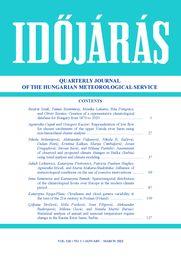Időjárás - Quarterly Journal of the Hungarian Meteorological Service (OMSZ)
Vol. 126, No. 1 * Pages 1–157 * January - March 2022
 |
|
 download [pdf: 5215 KB]
download [pdf: 5215 KB]
Creation of a representative climatological database for Hungary from 1870 to 2020
Beatrix Izsák, Tamás Szentimrey, Mónika Lakatos, Rita Pongrácz, and Olivér Szentes
DOI:10.28974/idojaras.2022.1.1 (pp. 1–26)
Beatrix Izsák, Tamás Szentimrey, Mónika Lakatos, Rita Pongrácz, and Olivér Szentes
DOI:10.28974/idojaras.2022.1.1 (pp. 1–26)
Regionalization of low flow for chosen catchments of the upper Vistula river basin using non-hierarchical cluster analysis
Agnieszka Cupak and Grzegorz Kaczor
DOI:10.28974/idojaras.2022.1.2 (pp. 27–45)
Agnieszka Cupak and Grzegorz Kaczor
DOI:10.28974/idojaras.2022.1.2 (pp. 27–45)
Assessment of observed and projected climate changes in Bačka (Serbia) using trend analysis and climate modeling
Nikola Milentijević,, Aleksandar Valjarević, Nikola R. Bačević, Dušan Ristić, Kristina Kalkan, Marija Cimbaljević, Jovan Dragojlović, Stevan Savić, and Milana Pantelić
DOI:10.28974/idojaras.2022.1.3 (pp. 47–68)
Nikola Milentijević,, Aleksandar Valjarević, Nikola R. Bačević, Dušan Ristić, Kristina Kalkan, Marija Cimbaljević, Jovan Dragojlović, Stevan Savić, and Milana Pantelić
DOI:10.28974/idojaras.2022.1.3 (pp. 47–68)
Influence of meteorological conditions on the use of coercive interventions
Jakub Lickiewicz, Katarzyna Piotrowicz, Patricia Paulsen Hughes, Agnieszka Micek, and Marta Makara-Studzińska
DOI:10.28974/idojaras.2022.1.4 (pp. 69–85)
Jakub Lickiewicz, Katarzyna Piotrowicz, Patricia Paulsen Hughes, Agnieszka Micek, and Marta Makara-Studzińska
DOI:10.28974/idojaras.2022.1.4 (pp. 69–85)
Spatiotemporal distribution of the climatological fronts over Europe in the modern climate period
Inna Semenova and Katsiaryna Sumak
DOI:10.28974/idojaras.2022.1.5 (pp. 87–108)
Inna Semenova and Katsiaryna Sumak
DOI:10.28974/idojaras.2022.1.5 (pp. 87–108)
Cloudiness and cloud genera variability at the turn of the 21st century in Poznań (Poland)
Katarzyna Szyga-Pluta
DOI:10.28974/idojaras.2022.1.6 (pp. 109–125)
Katarzyna Szyga-Pluta
DOI:10.28974/idojaras.2022.1.6 (pp. 109–125)
Statistical analysis of annual and seasonal temperature regime change in Rasina River basin, Serbia
Ljiljana Stričević, Mila Pavlović, Ivan Filipović, Aleksandar Radivojević, Milena Gocić, and Nataša Martić Bursać
DOI:10.28974/idojaras.2022.1.7 (pp. 127–157)
Ljiljana Stričević, Mila Pavlović, Ivan Filipović, Aleksandar Radivojević, Milena Gocić, and Nataša Martić Bursać
DOI:10.28974/idojaras.2022.1.7 (pp. 127–157)
IDŐJÁRÁS - Quarterly Journal

Az IDŐJÁRÁS a HungaroMet Nonprofit Zrt. negyedévenként megjelenő angol nyelvű folyóirata
Megrendelhető a journal.idojaras@met.hu címen.
A szerzőknek szánt útmutató itt olvasható.
Megrendelhető a journal.idojaras@met.hu címen.
A szerzőknek szánt útmutató itt olvasható.









